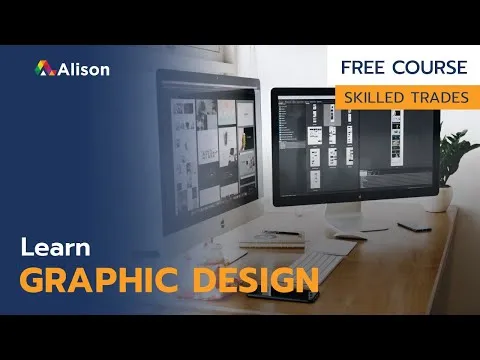
Introduction to Graphic Design 
Gain the foundational knowledge and tools necessary to become a graphic designer with this introduction to graphic design course. Learn concepts and software skills to help you create stunning visuals. ▼
ADVERTISEMENT
Course Feature
![]() Cost:
Cost:
Free Trial
![]() Provider:
Provider:
LinkedIn Learning
![]() Certificate:
Certificate:
No Information
![]() Language:
Language:
English
![]() Start Date:
Start Date:
Self Paced
Course Overview
❗The content presented here is sourced directly from LinkedIn Learning platform. For comprehensive course details, including enrollment information, simply click on the 'Go to class' link on our website.
Updated in [March 06th, 2023]
This course provides an introduction to the world of graphic design. It covers the concepts and software that are essential for any designer, such as Illustrator and InDesign. It explains how these fit into a typical graphic design workflow and provides an overview of vector-drawing techniques. Additionally, it covers document layout and print preparation processes. By the end of the course, students will have a better understanding of what graphic designers do and what they need to learn next. This course is an excellent starting point for anyone interested in pursuing a career in graphic design.
[Applications]
At the end of this course, students should have a better understanding of the concepts and software used in graphic design. They should be able to use Illustrator to create custom logos and understand vector-drawing techniques. Additionally, they should have an overview of the document layout and print preparation processes in InDesign. With this knowledge, students can apply their skills to create professional-looking designs and further their graphic design career.
[Career Paths]
1. Graphic Designer: Graphic designers create visual concepts, using computer software or by hand, to communicate ideas that inspire, inform, and captivate consumers. They develop the overall layout and production design for various applications such as advertisements, brochures, magazines, and corporate reports. With the increasing demand for digital media, graphic designers are now expected to be proficient in digital tools such as Adobe Photoshop, Adobe Illustrator, and Adobe InDesign.
2. User Interface (UI) Designer: UI designers are responsible for creating user-friendly interfaces for websites and mobile applications. They create the look and feel of the product, as well as the user experience. UI designers must have a strong understanding of user experience principles, as well as the ability to create visually appealing designs.
3. Motion Graphics Designer: Motion graphics designers create animated graphics for television, film, and the web. They use a variety of software programs to create motion graphics, such as Adobe After Effects, Cinema 4D, and Maya. Motion graphics designers must have a strong understanding of animation principles, as well as the ability to create visually appealing designs.
4. Web Designer: Web designers create the look and feel of websites. They use HTML, CSS, and JavaScript to create the user interface and user experience of a website. Web designers must have a strong understanding of web standards, as well as the ability to create visually appealing designs. With the increasing demand for mobile-friendly websites, web designers must also be proficient in responsive design principles.
[Education Paths]
1. Bachelor of Fine Arts (BFA) in Graphic Design: This degree program provides students with a comprehensive understanding of the principles of graphic design, including typography, color theory, and composition. Students will also learn how to use industry-standard software such as Adobe Photoshop, Illustrator, and InDesign. This degree is ideal for those who want to pursue a career in graphic design, as it provides a strong foundation in the fundamentals of the field.
2. Master of Fine Arts (MFA) in Graphic Design: This degree program is designed for those who want to take their graphic design skills to the next level. Students will learn advanced techniques in design, typography, and digital media. They will also gain a deeper understanding of the history and theory of graphic design. This degree is ideal for those who want to pursue a career in teaching or research in the field.
3. Master of Science (MS) in Graphic Design: This degree program is designed for those who want to specialize in a particular area of graphic design. Students will learn advanced techniques in a specific area, such as web design, motion graphics, or interactive design. This degree is ideal for those who want to pursue a career in a specialized area of graphic design.
4. Certificate in Graphic Design: This program is designed for those who want to gain a basic understanding of graphic design principles and techniques. Students will learn the fundamentals of design, typography, and digital media. This program is ideal for those who want to gain a basic understanding of the field and pursue a career in graphic design.
Course Syllabus
Introduction
What is graphic design?
Course Provider

Provider LinkedIn Learning's Stats at AZClass
With Introduction to Graphic Design, you'll gain the fundamentals and tools you need to become a graphic designer. Learners gain an understanding of the concepts and software used in graphic design, such as Illustrator and InDesign, and how they fit into a typical workflow. They can also learn how to create custom logos and use vector drawing techniques. Learners can learn how to use InDesign to create documents for printing including how to set up documents, add text and images, and prepare them for printing.
Discussion and Reviews
0.0 (Based on 0 reviews)
Explore Similar Online Courses

You CAN Speak Korean! - Learn Korean with Practical Conversations

Digital Transformation of Mining

Python for Informatics: Exploring Information

Social Network Analysis

Introduction to Systematic Review and Meta-Analysis

The Analytics Edge

DCO042 - Python For Informatics

Causal Diagrams: Draw Your Assumptions Before Your Conclusions

Whole genome sequencing of bacterial genomes - tools and applications

Complete Graphic Design Course Explaining Psychology (MUST KNOW)

Graphic Design Tutorial For Beginners Graphic Design (Full Course)


Start your review of Introduction to Graphic Design